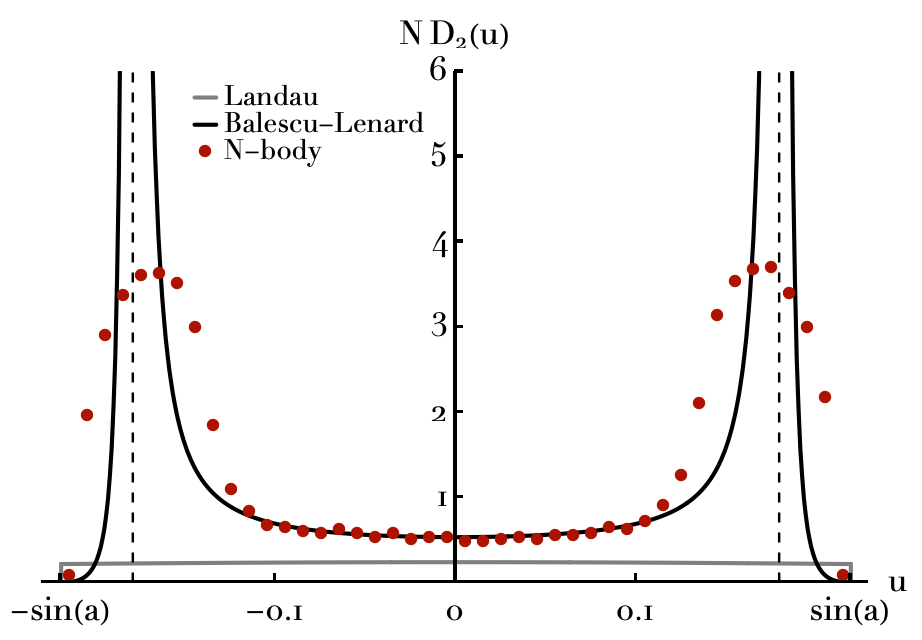Dynamics of self-gravitating systems close to marginal stability
Astrophysical Context
Galaxies, globular clusters, and galactic nuclei are made of a large number of stars. As such, their long-term evolution can only be described statistically. For example, the celebrated Vlasov and Jeans equations are appropriate to describe orbital evolutions on rapid timescales as driven by the system’s mean gravitational potential (e.g., ~200 million years for the Sun in the Milky Way). On longer timescales, as result of stochastic perturbations, stellar orbits unavoidably reshuffle. The Fokker—Planck, Landau or Balescu—Lenard equations are examples of kinetic equations that quantitatively describe the long-lasting effects of resonant, amplified and long-range dynamical couplings between stars.
In practice, the mathematical description of self-gravitating systems shares some deep and profound connexions with the one of electrostatic plasmas. Indeed, in both systems, the inter-particle interactions are primarily governed by coherent forces from distant forces, as opposed to quasi-random forces from violent collisions with nearby particles. As such, stellar clusters and plasmas exhibit many equivalent processes, such as Landau damping, dynamical friction, resonant relaxation and polarisation effects.
Yet, gravity presents one key peculiarity: it is attractive. This strongly favors instabilities. There is no shortage of such examples in astrophysics: bisymmetric spiral arms in galactic discs, radial orbit instability in globular clusters, or eccentric stellar discs around supermassive black holes. Because stellar systems naturally explore distributions close to the instability threshold, it is essential to develop a kinetic framework for dynamically cold self-gravitating systems, i.e. stellar systems close to marginal stability.
Upshot
This is where the heart of the present PhD project lies. Its goal is to investigate the long-term evolution of marginally stable self-gravitating systems through a novel and innovative framework. In particular, the PhD candidate will focus on alleviating some of the key limitations of present state-of-the-art kinetic equations in the vicinity of (linear) instabilities. Once completed, this project will have highlighted the versatility of statistical methods to describe the intricate evolution of dynamically cold stellar systems.
Objectives
- The Balescu—Lenard equation (Heyvaerts2010) diverges when the system nears an instability. This is an unphysical divergence: it begs for correcting the kinetic equation in the cold limit. Following Rogister+1968 and Hamilton+2020, the PhD candidate will generalise the Balescu—Lenard operator to account for contributions from mode-particle couplings. How efficiently can (long-lasting) damped modes drive orbital evolution?
- Once armed with a fully regularised kinetic theory, the PhD candidate will use it quantitatively to (i) constrain astrophysical relaxation close the Jeans instability (Magorrian2021) and (ii) to understand the redistribution of orbital orientations around a supermassive black hole (Fouvry+2019). Here, the astrophysical focus will be the emphasis on the crucial role played by collective amplification in dynamically susceptible systems. How fast can a stellar system truly relax?
- Orbital relaxation is inherently a stochastic process. In that view, one may use large deviation theory to characterise the full likelihood of fluctuations as evolution occurs. Building upon Feliachi+2023, the PhD candidate will investigate dynamical deviations in marginally stable systems, i.e. when collective effects cannot be neglected. Ultimately, this will offer new venues to constrain the phase transitions that occur in spiral galaxies (see, e.g., De Rijcke+2019). How likely are these abrupt and irreversible dynamical excursions?
- Contrary to plasmas, stellar clusters typically sustain a finite range of orbital frequencies. For example, the presence of a maximum inner Lindblad resonance frequency in galactic discs is crucial for the survivability of the disc’s inner bar. Yet, this particularity also leads to the presence of branch cuts in the cluster’s linear response function (Barre+2013). As a result, associated fluctuations in the cluster decay only algebraically in time, i.e. much more slowly than the damped Landau modes. What is the importance of branch cuts in the stationary spectrum of thermal fluctuations in stellar clusters?
Requirement
Strong interest in theoretical astronomy, dynamics, analytical and numerical work.
Framework
PhD supervised by Jean-Baptiste Fouvry at the Institut d'Astrophysique de Paris and co-supervised by Julien Barré at the Institut Denis Poisson (Orléans)






